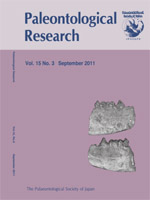We reappraise the type and only known specimen of “Brachyodus” japonicus Matsumoto in Tokunaga, which is an anthracothere (Mammalia, Cetartiodactyla) discovered from the Oligocene Nakazato Formation of the Sasebo Group (Japan) in the early 20th Century. The specimen is a mandibular fragment with p4-m2 and is now housed in the National Museum of Japanese History (Sakura, Japan). The geologic age of the species is set at the middle part of the Oligocene on the basis of fission-track datings. Compared to Brachyodus, the present specimen is much smaller in size and has a more mesiodistally elongated p4, indicating that it is not referable to Brachyodus. Instead, it is comparable in dental morphology and size to Elomeryx in having moderately selenodont molars and a mesiodistally elongated p4 with a distinct paraconid and metaconid. Compared to other species of Elomeryx, it is unique in that p4 has a wider talonid and a better developed distobuccal cingulum, suggesting that “Brachyodus” japonicus is a distinct species of the genus Elomeryx. Therefore, we rename this species Elomeryx japonicus. Reconsidered as such, the specimen yields significant information concerning the paleobiogeography of the poorly understood East Asian Oligocene anthracotheres and the origination and early evolution of “advanced bothriodontines” on different landmasses.
How to translate text using browser tools
1 September 2011
Reappraisal of “Brachyodus” japonicus, an Oligocene Anthracotheriid Cetartiodactyl from Japan
Takehisa Tsubamoto,
Naoki Kohno
ACCESS THE FULL ARTICLE

Paleontological Research
Vol. 15 • No. 3
September 2011
Vol. 15 • No. 3
September 2011
Anthracotheriidae
Brachyodus japonicus
Elomeryx
Japan
Oligocene
Sasebo Group




